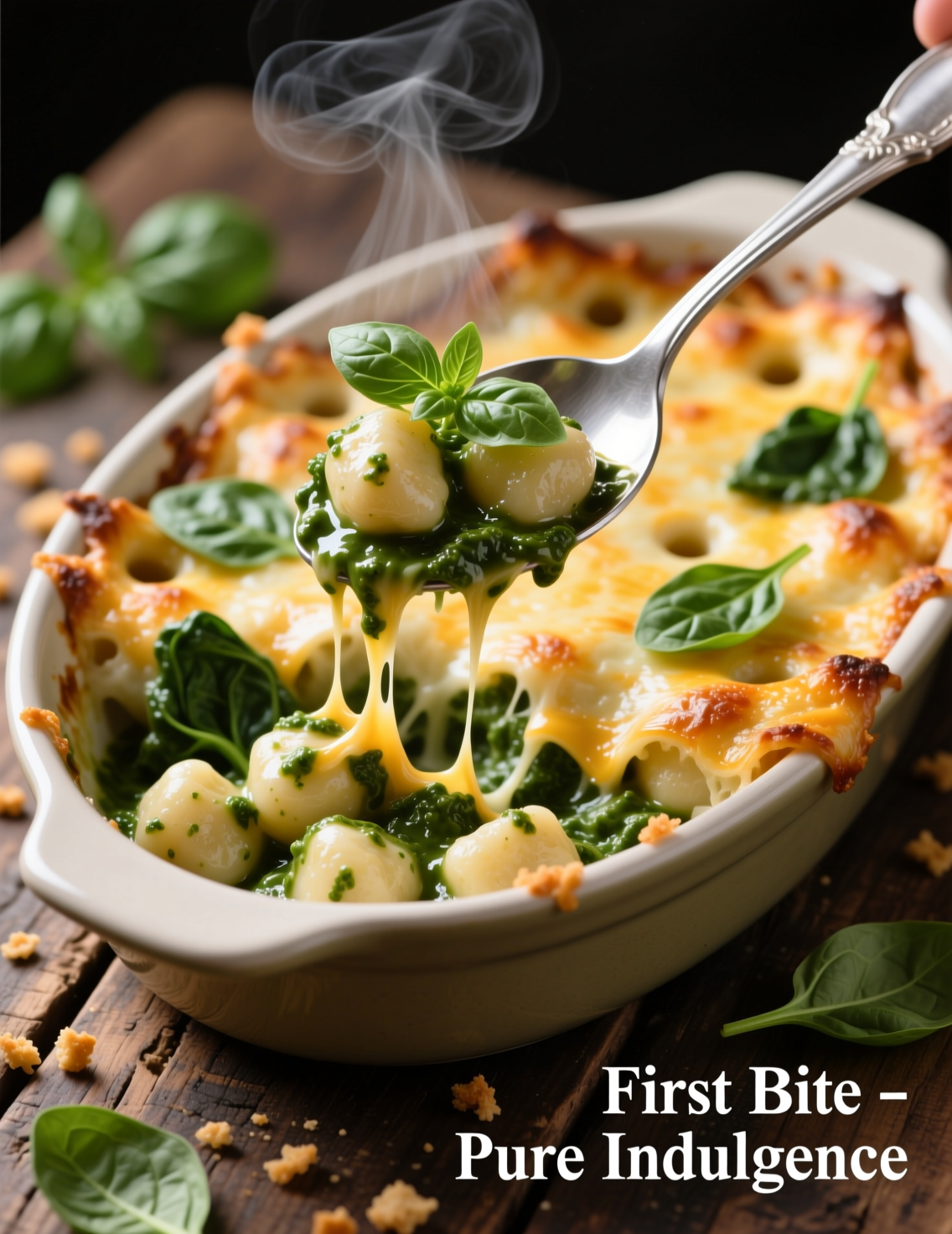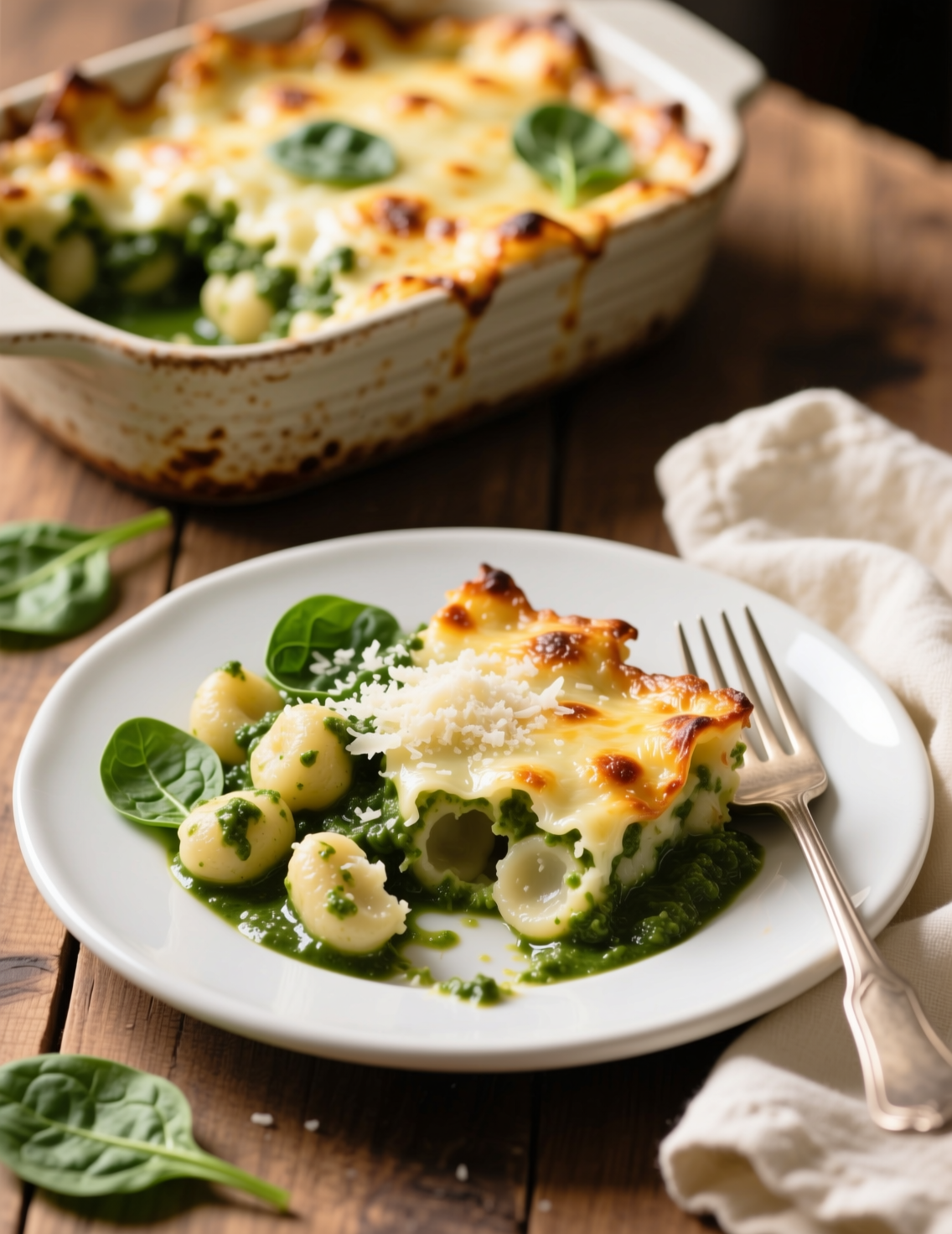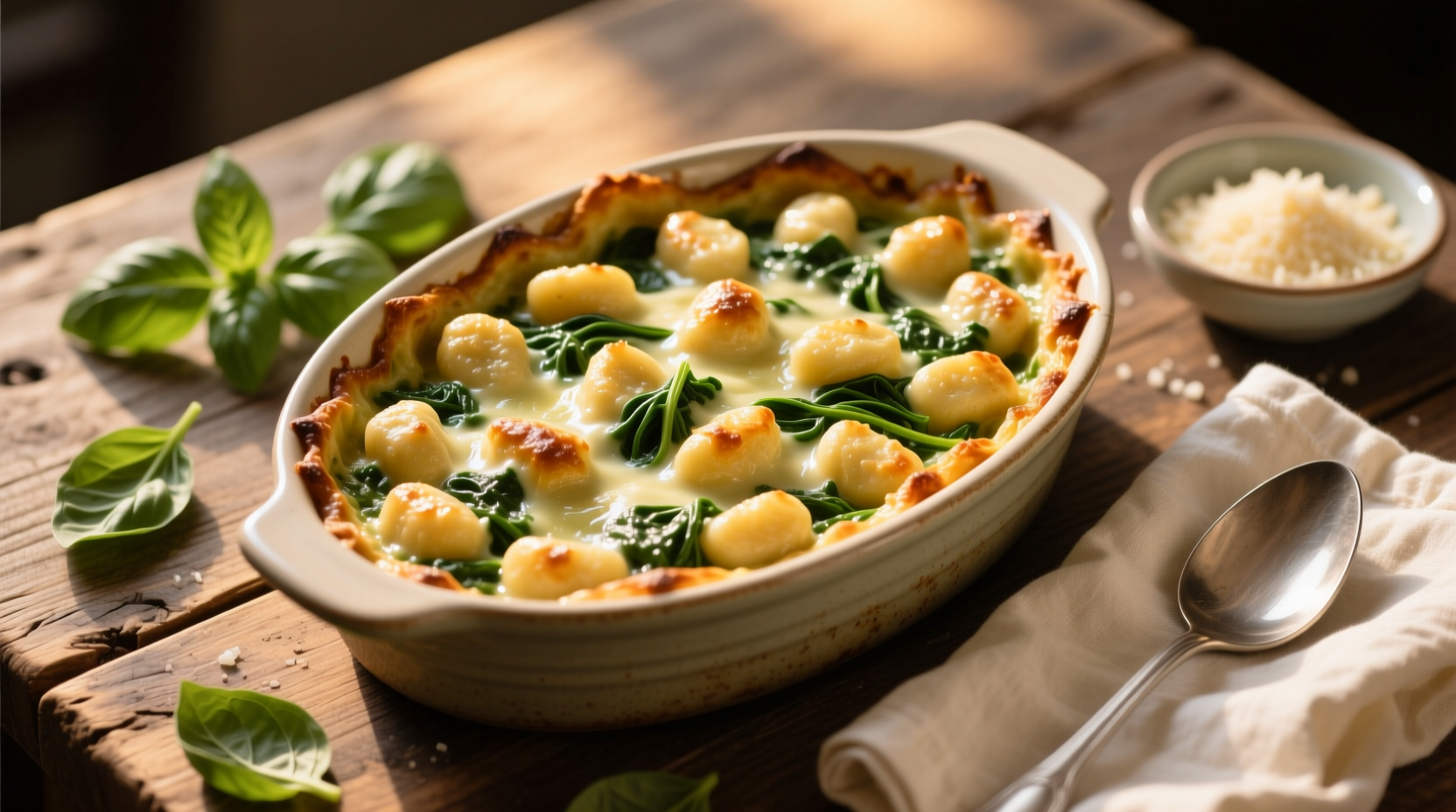The smell hits first—garlicky basil pesto melting into cream, baked until it bubbles like a small volcano trapped in porcelain. Few pasta dishes manage that kind of sensory ambush, but a creamy pesto spinach gnocchi bake does it with almost unfair ease. If you’re serving four, you’re not really feeding just four. You’re orchestrating an edible mood shift. This isn’t merely food; it’s edible architecture stacked with starch, greens, cheese, and sauce that acts like warm velvet on the tongue.
Why Gnocchi Is Different From Pasta
Gnocchi, those pillowy little dumplings, don’t come from the same universe as spaghetti or rigatoni. Their DNA is potato, flour, and sometimes egg. They cook in less than three minutes. They absorb flavor like sponges left too long in pesto jars. For professional cooks, gnocchi is one of those staples that can go wrong quickly if texture balance is off—too heavy and the bake becomes leaden, too light and it collapses under creamy sauces.
Italy doesn’t even agree on what gnocchi should always be. Roman gnocchi is made from semolina, while the north tends to love potato-based versions. For this recipe, potato gnocchi is king because its mild flavor lets spinach and pesto roar. If spinach is the singer, gnocchi is the stage lighting. It enhances but never outshines.
Why Baked Gnocchi Recipes Are Trending
Professional kitchens and home cooks alike have shifted toward baked gnocchi recipes. Search data from Google shows queries for “gnocchi bake recipes” have increased by nearly 40% in the last three years. Why? Because diners crave two things at once: the comfort of baked casseroles and the sophistication of Italian flavors.
Unlike lasagna, which feels laborious, gnocchi bakes slide into the weeknight slot. They also reheat beautifully, making them appealing to meal-prep lovers. Spinach adds nutrition, while pesto answers the call for “green wellness food” without tasting like a punishment. In short, gnocchi bake recipes are a sweet spot in culinary trends.

Anatomy of Creamy Pesto Spinach Gnocchi Bake
To break down the recipe into professional terms, consider it a layered flavor build. Each ingredient carries weight in the structure.
- Gnocchi (1 lb): Store-bought works for consistency, though handmade gnocchi delivers superior texture.
- Pesto (1/2 cup): Basil pesto is standard, but kale or arugula pesto can bring bitterness that balances cream.
- Spinach (5 oz): Fresh leaves wilt faster and retain brightness compared to frozen.
- Cream (1 cup heavy cream): Carries fat to coat gnocchi, ensuring smooth mouthfeel.
- Cheese (1 cup mozzarella, 1/2 cup Parmesan): One melts, one sharpens. They create the top crust, golden and stringy.
- Garlic & Onion (2 cloves, 1 small): Aromatics that keep the dish from flattening out.
- Olive oil & Butter (2 tbsp each): Provide richness and help emulsify cream with pesto.
Notice how every ingredient isn’t just filling space—it’s performing an active role in flavor chemistry. Professional cooking isn’t about “just tossing things together.” It’s about understanding why spinach should be wilted before mixing, or why gnocchi must be parboiled rather than fully boiled before baking to prevent sogginess.
Cooking Technique: Professional Adjustments
Cooking gnocchi is a delicate dance. Drop them in boiling salted water and as soon as they float, they’re technically “done.” But for a bake, undercook them slightly. Pull them out 30 seconds early. Why? Because the oven will finish the job, and overcooked gnocchi turn into gummy erasers.
The spinach must also be treated gently. Sautéing it quickly with garlic in butter allows water to evaporate. Skip this step and you’ll bake yourself a watery disaster. Professional chefs talk about “water management” in baked pasta dishes—spinach holds nearly 90% water by weight, so ignoring this fact is recipe sabotage.
When pesto meets cream, don’t dump one into the other cold. Heat cream until it simmers, then whisk pesto gradually. This prevents separation. In high-volume kitchens, cooks often ruin pesto cream sauces by skipping emulsification, ending up with oily puddles.
Baking Science Behind the Golden Crust
Cheese isn’t only about flavor. It’s physics. Parmesan provides browning because of its low moisture and high protein. Mozzarella stretches but doesn’t brown deeply on its own. Combined, they create a crust that looks like someone painted it with golden lacquer.
Research on the Maillard reaction shows that temperatures above 285°F trigger complex flavor compounds in proteins and sugars. When the bake sits at 375°F for 20 minutes, you’re hitting that sweet zone where gnocchi stays tender inside, while the top transforms into crunchy, bubbling heaven.
Flavor Variations for Professionals
Professional kitchens rarely stick to the recipe as written. A chef might swap spinach for Swiss chard, which offers more bite. Pesto could be walnut-based instead of pine nut, cutting costs without sacrificing richness. Adding grilled chicken strips transforms the dish into a full entrée for higher menu pricing.
Seasonal tweaks matter, too. In autumn, roasted pumpkin cubes layered with gnocchi bring sweetness against pesto’s herbal sharpness. In spring, peas and asparagus tips lighten the heaviness. The base recipe works as a blank canvas, letting chefs adapt according to availability and food costs.

Nutritional Balance and Consumer Appeal
Consumers today are hyper-aware of nutritional density. Spinach contributes iron, vitamin K, and folate. Pesto, though calorically dense, delivers antioxidants through basil and heart-healthy fats from olive oil. One serving of this dish averages about 520–580 calories, depending on cheese ratios.
For health-conscious menus, swapping cream for Greek yogurt reduces fat by nearly 40% while maintaining creaminess. Dairy-free versions are trending as well—cashew cream combined with nutritional yeast mimics both cream and cheese, pulling in the vegan demographic. Market data shows plant-based “comfort food” menu items now account for over 20% of casual dining innovations in North America.
Step-by-Step Professional Recipe
Ingredients (4 servings)
- 1 lb potato gnocchi
- 1 cup heavy cream (or cashew cream for dairy-free)
- 1/2 cup basil pesto
- 5 oz fresh spinach
- 1 cup shredded mozzarella
- 1/2 cup grated Parmesan
- 1 small onion, finely chopped
- 2 cloves garlic, minced
- 2 tbsp olive oil
- 2 tbsp butter
- Salt and black pepper to taste
Method
- Preheat oven to 375°F (190°C).
- Boil gnocchi in salted water until they just float. Drain immediately.
- In a skillet, heat butter and olive oil. Add onion, sauté until translucent. Add garlic, then spinach. Cook until wilted and moisture evaporates.
- Heat cream gently in a saucepan. Whisk pesto into cream until emulsified. Season with salt and pepper.
- Combine gnocchi, spinach, and pesto cream in a large bowl. Mix gently.
- Transfer mixture to a buttered baking dish. Top with mozzarella and Parmesan.
- Bake 20 minutes until golden and bubbling. Rest for 5 minutes before serving.
Pairing and Serving Recommendations
Pairing matters more than people think. This gnocchi bake loves a glass of crisp Sauvignon Blanc. The acidity cuts through cream like scissors through silk. For red lovers, a light Chianti works because it doesn’t bulldoze pesto’s herbal notes.
Serve with a simple side salad—something bitter like arugula with lemon dressing. Why? Because balance. Rich, creamy mains need sharp, fresh companions. Too often, chefs overload the table with heavy sides, creating fatigue instead of harmony.
Common Mistakes to Avoid
- Overcooking gnocchi: Turns them gummy. Always undercook before baking.
- Skipping spinach sauté: Leads to watery bake.
- Pouring cold pesto into hot cream: Causes separation and oily pools.
- Excessive cheese: Smothers flavors; balance mozzarella with sharp Parmesan.
Even professional cooks can stumble here. I’ve seen chefs rush spinach prep in service kitchens, only to pull watery trays from the oven. Respect the small details.
Why This Dish Works in Professional Menus
On restaurant menus, this recipe hits multiple sweet spots: cost-effective (potato gnocchi is cheap), flexible (seasonal veggies adapt well), and profitable (comfort food dishes often price higher than their cost). Portion control is easy. And visually? That golden-baked crust under dim restaurant lights practically sells itself.
Catering operations love it too. Bake in large trays, portion with a spatula, and the dish holds heat well for service lines. Unlike risotto, which clumps quickly, baked gnocchi retains creamy consistency for longer.
The Emotional Pull of Baked Gnocchi
Food isn’t just nutrition—it’s memory creation. Creamy pesto spinach gnocchi bake lands in the “comfort nostalgia” category. Diners feel like they’re being taken care of. The softness of gnocchi, the creamy hug of sauce, the green glow of spinach—it tastes like reassurance on a plate.
Culinary psychology studies even suggest that green-colored foods influence perceptions of health, regardless of actual calorie load. So, diners see green flecks of spinach and pesto and subconsciously think, “better choice.” It’s a clever culinary trick that professionals can exploit without guilt.
Conclusion: Why You Should Master This Dish
Creamy pesto spinach gnocchi bake isn’t complicated. But it’s layered with culinary science, technique, and consumer psychology. Mastering it gives chefs a versatile dish that works in homes, restaurants, and catering halls.
The key lessons? Manage water, respect emulsification, balance cheese, and undercook gnocchi before baking. Adapt with seasonal variations. Pair thoughtfully. Avoid shortcuts that destroy texture.
In professional kitchens, the dish embodies what modern diners crave—comfort that feels refined. Learn to bake it right, and you won’t just feed people. You’ll persuade them to come back for another spoonful tomorrow.
FAQs
What type of gnocchi works best for this bake?
Potato gnocchi works best because it’s mild and soaks up the pesto cream beautifully.
Can I use frozen spinach instead of fresh?
Yes, but thaw and squeeze out all excess water to avoid a soggy bake.
How do I stop the sauce from splitting?
Warm the cream first, then whisk in pesto gradually for a smooth emulsion.
Should gnocchi be fully cooked before baking?
No, undercook slightly since the oven will finish the cooking.
Can I make this dish ahead of time?
Yes, assemble it, refrigerate, then bake just before serving.
What cheeses are best for the topping?
Mozzarella for meltiness and Parmesan for sharp golden flavor.
How long does it take to bake?
Around 20 minutes at 375°F until the top is bubbly and golden.
Can this recipe be made dairy-free?
Yes, use cashew cream and nutritional yeast instead of cream and cheese.
What wine pairs well with this dish?
Sauvignon Blanc for freshness or a light Chianti for balance.
Is creamy pesto spinach gnocchi bake healthy?
It’s indulgent but spinach and pesto add nutrients; lighter versions are possible.

Mariana is a passionate home cook who creates delicious, easy-to-follow recipes for busy people. From energizing breakfasts to satisfying dinners and indulgent desserts, her dishes are designed to fuel both your body and hustle.
When she’s not in the kitchen, she’s exploring new flavors and dreaming up her next recipe to share with the Foodie Hustle community.

